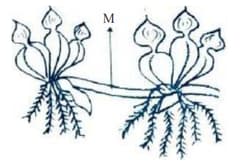Give examples of adventitious buds.
Important Questions on Plant Morphology and Anatomy
Identify the vegetative propagule in the following diagram:

Trap leaves supply nitrogen to Nepenthes plant
Grape vines differ from watermelon by having tendrils developed from axillary bud
Balancing roots of Eichornia arise from horizontally growing lateral branches
Gall flowers of Ficus store eggs of Blastophaga
A) A bud is present in the axil of leaflets of the compound leaf.
B) Casuarina has limited growth of branches as phylloclades.
C) Sub aerial stem of Oxalis spread to new niches when old parts die.
D) Pericarp and seed coat fuse together in caryopsis.
In Mimosa pudica, thigmotropism helps in protection, whereas in bitter-guard tendrils help in _____.
Taeniophyllum, Casuarina, Asparagus, Bougainvillea, Dioscoria, Opuntia, Hibiscus, Chrysanthemum
Select the option that is correct for the description of subaerial modification.
(a) A slender lateral branch arises from the base of the main axis and, after growing aerially for some time, arches downwards to touch the ground.
(b) A lateral branch originates from the basal and underground portion of the main stem, grows horizontally beneath the soil, and comes out obliquely upwards, giving rise to a leafy shoot.
Students were on the excursion to a botanical garden. They noted the observation given below. Will you be able to help them in understanding those conditions?
A wiry outgrowth was seen on a plant arising from in between the leaf and stem.
The underground stem of some plants such as grasses, strawberry is concerned with
(a) Perennation.
(b) Vegetative propagation.
(c) Moisture absorption.
(d) Food assimilation.
(e) Spread to new niches.
Students were on the excursion to a botanical garden. They noted the observation given below. Will you be able to help them in understanding those conditions?
There was a green plant with flat stem, but no leaves. The entire plant was covered by soft spines.

